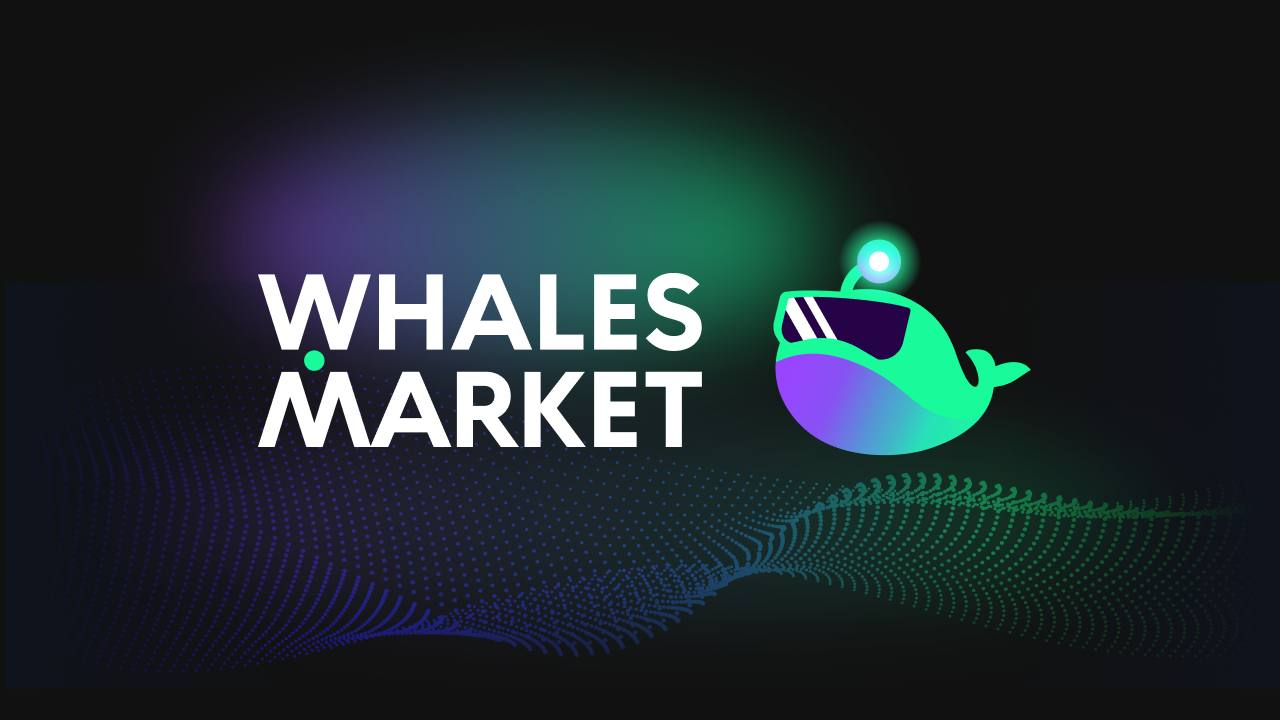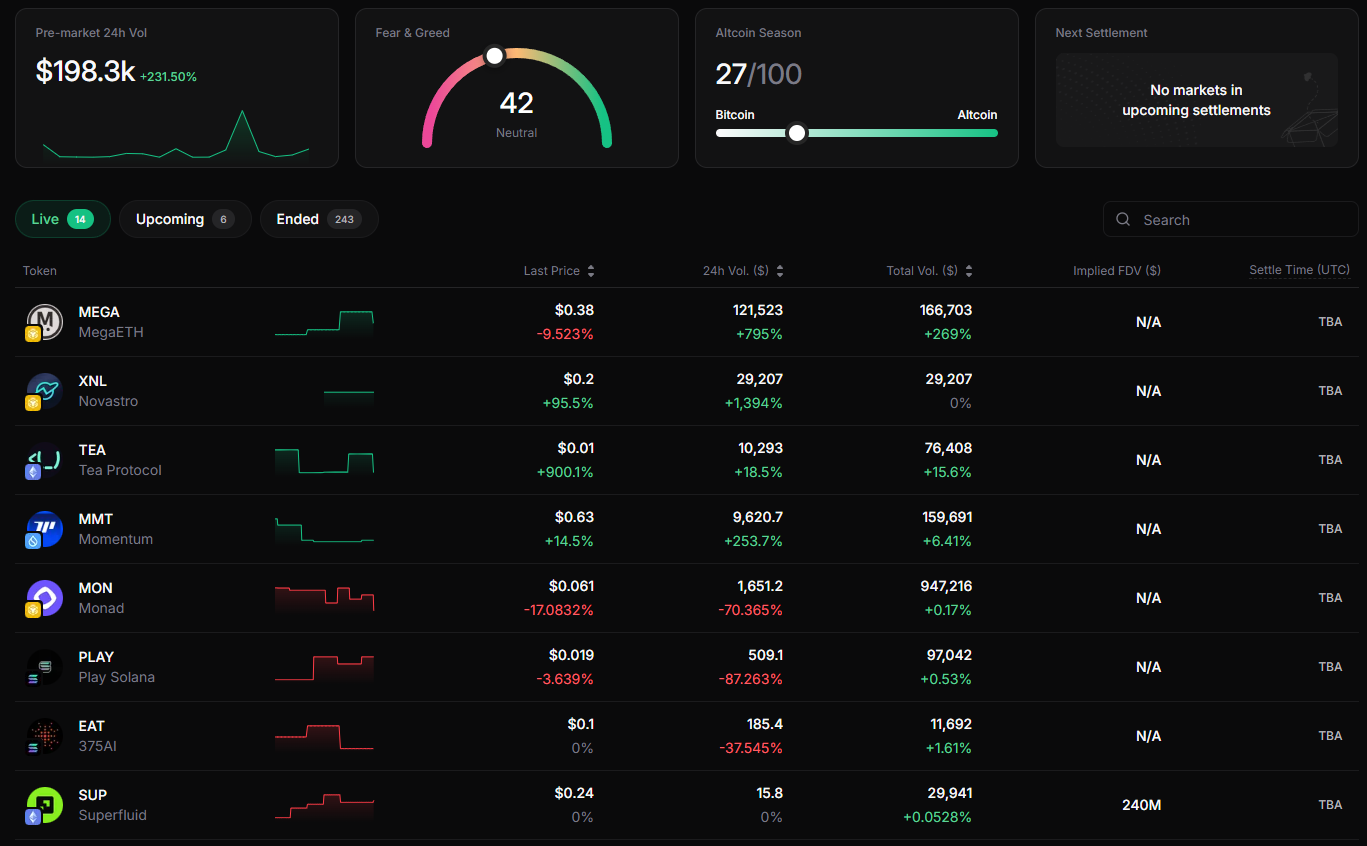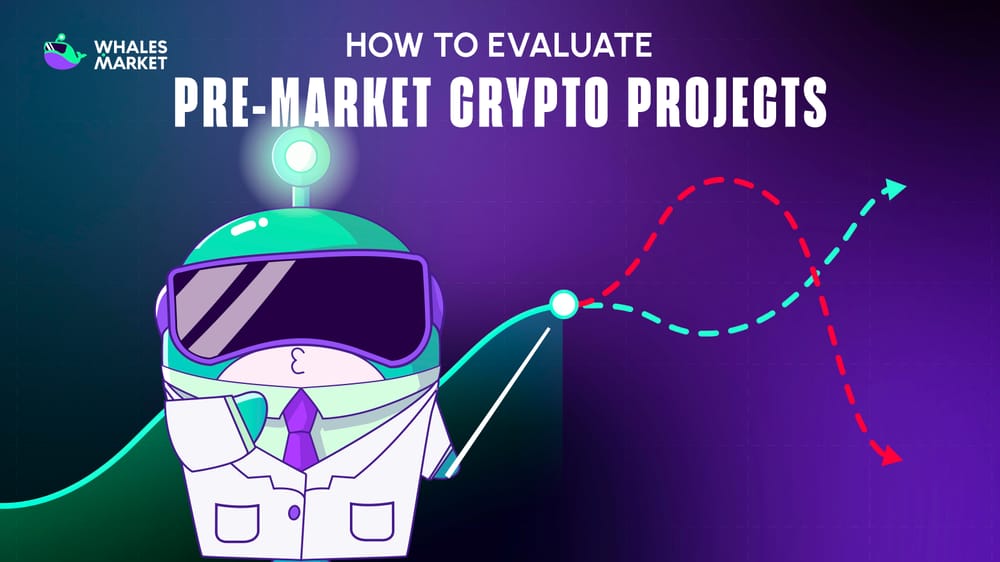Premarket crypto refers to the trading of unlisted tokens or allocations before they are officially launched on exchanges. Also known as crypto pre-market or OTC pre-market, it gives traders early access to projects, allowing them to speculate on potential value and establish crypto pre-market prices ahead of public trading.
However, not every early-stage project is worth investing in and identifying the right ones requires proper evaluation. In this article, let's learn how to evaluate a premarket crypto project effectively before committing capital.
What is premarket crypto?
Premarket crypto is the trading of high-potential tokens before the official Token Generation Event (TGE). It offers traders an opportunity to gain early access to new projects.
The term Pre-Market was first introduced and popularized in crypto by Whales Market. It refers to peer-to-peer trading of token allocations before the official TGE. Today, Whales Market stands as the leading pre-market DEX platform, having facilitated over $300M trading volume to date. This substantial volume, secured via their smart contract infrastructure, demonstrates the massive and verifiable demand for crypto pre-market opportunities.
Premarket Assets: Tokens and Allocations Before TGE
Several types of assets are commonly traded in premarket crypto:
- Token Allocations (Private Sale Claims): Claims representing the right to receive tokens from a project’s private funding rounds (Seed, Strategic, etc.). These are typically bought by venture capitalists or large investors and are often sold at a pre-TGE valuation that is significantly lower than the expected launch price.
- Future Token Airdrop Claims: Earned through community participation. Sellers who have actively farmed these rewards and know their estimated allocation trade this claim to monetize their effort instantly, rather than waiting for the official TGE and airdrop distribution.
On Whales Market, these assets are traded via smart contracts, ensuring secure delivery and accurate pricing without the risks of informal OTC networks.

Key Metrics to Evaluate Premarket Crypto Projects
Before participating in crypto pre-market trades, investors should consider several evaluation metrics:
- Team credibility: Look for founders and teams with verified backgrounds, transparent information, and a solid track record in the crypto space. A trustworthy team reduces the risk of non-delivery or project abandonment post-launch, helping secure your premarket crypto allocation.
- Tokenomics: A clear indicator of project sustainability. Look for projects with balanced tokenomics and a long vesting schedule (typically over 12 months of cliff and vesting for team or private investors). Such structures reduce early sell pressure and support stable crypto pre-market prices after TGE, reflecting healthier long-term project growth.
- Project roadmap: Compare the crypto pre-market Fully Diluted Valuation (FDV) to competitors. A pre-launch FDV that is 25-50% lower than comparable listed projects suggests a strong upside. Crucial for identifying undervalued allocations and calculating potential ROI from the current premarket crypto price.
- Community engagement: Strong, non-bot organic growth. Indicates genuine interest and potential market demand needed to sustain the crypto pre-market price once listed.
- Platform tools: Monitor the Filled Order Volume and Average Sale Price on Whales Market for the specific token. High volume suggests high confidence; a stable price indicates market equilibrium. Provides a real-time, on-chain gauge of the market's collective valuation before the token hits major exchanges.
Analyzing Crypto pre-market Prices on Whales Market
Understanding pricing is critical in OTC pre-market trading. Traders can use Whales Market’s transparent, on-chain records to gain an edge:
- Identify Arbitrage Opportunities: By tracking on-chain data, a user can spot when an allocation is listed at an unusually low crypto pre-market price, allowing a potential high-return trade when the token lists on a major exchange.
- Set Realistic Expectations: Comparing the final premarket crypto price to the initial listing price of comparable, successful projects (e.g., projects that saw a 5x-10x price surge from private sale round to public listing) helps in minimizing the risk of overpaying.
- Filled Order Volume: Represents the total amount of tokens successfully traded through Whales Market’s smart contracts. A rising filled volume indicates strong market participation and liquidity, showing that both buyers and sellers actively trust the settlement process and project potential.
- 24h Trading Volume: Shows the amount of trading activity over the past 24 hours. Rising 24h volume typically signals growing interest or renewed speculation as the project’s TGE approaches, helping traders identify periods of high liquidity and demand.
- Price Trend (Last Price + Chart): The “Last Price” and the mini price chart on Whales Market visualize short-term price movements for each token. Monitoring these trends helps traders understand whether market sentiment is turning bullish (rising prices) or cautious (declining prices), allowing them to time their entries and exits more effectively.

Market Indicators on Whales Market
Whales Market provides transparent, real-time indicators that help users evaluate premarket sentiment and liquidity before a token’s official launch. Each metric is derived directly from on-chain trading data displayed on the dashboard.
1. Last PriceShows the most recent transaction price of the token’s allocation. It reflects the current market consensus on project valuation before TGE and helps identify short-term sentiment shifts.
2. 24h Volume ($)Represents the total trading volume in the past 24 hours. A spike in 24h Volume signals increasing trader activity and confidence, often triggered by project news or community engagement.
3. Total Volume ($)Tracks the cumulative traded amount since the listing went live. It measures overall market participation, higher totals indicate sustained liquidity and community trust in the project.
4. Implied FDV ($)Shows the implied Fully Diluted Valuation derived from the token’s premarket price. This lets traders benchmark a project’s valuation against comparable listed tokens, revealing potential undervaluation opportunities.
5. Market Sentiment IndicatorsAt the top of the dashboard, Whales Market visualizes Fear & Greed and Altcoin Season indices, both updated dynamically to provide a macro view of market mood and risk appetite across all premarket trades.
Conclusion
Premarket crypto offers investors early access to promising projects, potential profit, and strategic opportunities, but these benefits are only realized when trading is conducted safely. To navigate this space effectively, it is essential to perform thorough due diligence by evaluating the project team, roadmap, and tokenomics, while carefully analyzing crypto pre-market prices and comparing them with post-TGE expectations.
Leveraging trusted platforms like Whales Market further enhances security by mitigating fraud risk, providing multi-chain trading access, and ensuring collateral-secured settlements. By combining careful evaluation with the transparent, on-chain trading features offered by Whales Market, investors can confidently participate in OTC pre-market opportunities and maximize their potential gains.
Disclaimer: This article is for informational purposes only, not investment advice, and Whales Market is not responsible for any of your investment decisions.
FAQs
What is the primary benefit of investing in premarket crypto?
The main benefit is early access to potential upside before a token lists publicly. By trading in the crypto pre-market, investors can acquire allocations at valuations often lower than the expected TGE or exchange listing price.
How does Whales Market secure a premarket crypto trade before the tokens are even issued?
Whales Market secures all premarket trades using on-chain, fully collateralized smart contracts. When a buyer and seller agree to a trade, both sides deposit collateral (typically stablecoins or equivalent assets) into the smart contract.
How do I evaluate the fair crypto pre-market price of an unlisted token?
To evaluate a fair crypto pre-market price, combine data, benchmarks, and project fundamentals. Start by comparing similar projects with equivalent market caps or narratives, then analyze on-chain data such as investor backing, token allocation, and community engagement. Use pre-market platforms like Whales Market to gauge real buy/sell demand, and adjust the valuation for risks like token lock-ups, liquidity, and TGE uncertainty.
Is buying premarket crypto on Whales Market safer than traditional OTC trading?
Yes, significantly safer in terms of counterparty risk. Traditional OTC pre-market deals are often conducted privately without audits, escrow, or on-chain settlement, leaving traders exposed to fraud or non-delivery.
Whales Market replaces this with fully collateralized on-chain smart contracts, ensuring that funds are securely locked until settlement. This platform has already facilitated over $300 million in trading volume, according to Whales Market’s official documentation.
What are the main risks associated with premarket crypto trading?
The main risks are project risk and liquidity risk. A project may fail to launch, face delays, or list at a lower price than its pre-market value. Liquidity can also be limited before TGE, making it harder to exit positions. Conducting thorough due diligence on the project’s team, roadmap, and tokenomics is essential to mitigate these risks.
Can I trade tokens from any blockchain in the crypto pre-market?
Yes. Whales Market supports multi-chain access, allowing users to trade pre-market assets from different ecosystems such as Solana, Ethereum, Base, and Arbitrum. Each blockchain operates independently, traders simply connect the relevant wallet to buy or sell allocations on that specific network.

